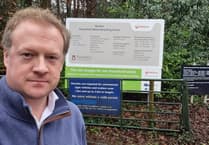THE first day back after the summer break proved an exciting one for children at St Lawrence Primary School thanks to an emergency evacuation to fell a diseased beech tree.
According to Alton Town Council leader Peter Hicks, a fungal growth had appeared between the buttress roots of the tree after a period of heavy rain and it was showing signs of distress.
The tree stands in the playground of St Lawrence Primary School, overhanging a public footpath through the churchyard, and just a stone’s throw from the Grade I Listed church itself.
It’s an area that just days earlier had been packed with hundreds of visitors and English Civil War Society re-enactors firing muskets and cannons as they recreated scenes from the 1643 Battle of Alton.
According to Alton tree warden Jim Dickinson, while it is not a battle the tree would have witnessed as it was only around 200 years old, in more recent years it has had its own fight for life as its roots have been encased in Tarmac, depriving them of air they need to survive.
“I’m amazed the tree has lasted so long,” said Mr Dickinson, who explained that while the part of the tree above the ground appeared relatively healthy, it was the fungal growth around the base that gave cause for concern. He added that the fungus had undoubtedly been removed from time to time to prevent the children touching it, so the disease had probably gone unnoticed.
But the recent spate of wet weather had resulted in further growth and closer inspection by Mr Dickinson revealed the true extent of the problem.
In a report to Alton Town Council dated August 24, Mr Dickinson described how “large fungal fruiting bodies, distinctive to meripilus giganteus (giant polypore) have grown from the basal buttresses of the trunk”.
These confirmed that “the fungal mycelium is rife throughout most of the roots, so the strength of the entire root system is severely compromised”.
Furthermore, the growth of twigs in the canopy had declined over the years to form only short extensions in length annually – another indicator of “collapsing systemic vigour”.
So Mr Dickinson’s advice was clear: “This tree is, or will soon become, unstable. In my view the tree should be regarded as an immediate danger to anyone using the footpath.”
As the main weight of the tree tended to be over what is a well-used footpath, leading through the churchyard and to the entrance to the school, and with the new term about to begin, Mr Dickinson felt it could put many children at risk.
While subject to a Tree Preservation Order, once the urgency was established, according to Mr Dickinson, the East Hampshire District Council (EHDC) planning process was fast forwarded and the decision taken to fell under a special five-day order.
As a result, as the children returned to school last Wednesday an urgent site meeting was convened involving local county councillor Andrew Joy, Mr Hicks, and officers from Hampshire County Council.
The school had to be accessed via the back door and the junior school children were evacuated to neighbouring Amery Hill School for their lessons, while the younger children remained behind in the part of the school furthest from the tree.
The Amery Hill pupils were not due back until Friday, by which time the canopy had been stripped out. Now stable, the trunk is expected to be taken down to ground level, possibly over the half-term break.
County council spokesman Sean Woodward said: “The tree was, unfortunately, infected with the fungal disease meripilus giganteus, an infection trees do not recover from. Felling began last Thursday and the area was made safe by the end of the day. While the work was going on, St Lawrence’s school playground was closed, three classes were temporarily located to Amery Hill Academy, and alternative arrangements were made for school lunch.”
He added: “I would like to thank all the staff, children and parents at St Lawrence Primary School for their co-operation while alternative arrangements were in place that day, to Amery Hill Academy for accommodating the extra classes, and to the vicar of St Lawrence Church while access to the churchyard was restricted.”
According to Mr Hicks, once the tree is completely felled, due to restricted access it is unlikely that the wood will be removed. Instead the logs will be stacked up in the churchyard for public use.
Mr Dickinson also confirmed that the large beech standing next to the diseased tree is healthy and that the fungal infection was not related in any way to the disease attacking larch trees in nearby Chawton Park Wood.



